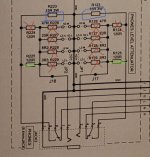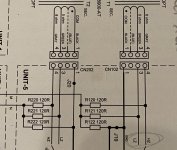I've been using my HIfiman HE6 off the speaker taps of the TU8900 fed by the Chord Dave and sonics wise it's hitting it right out of the park and into orbit.
I can see how that would, shall we say, not suck. Totally ideal use case.
And I take your point that the Elekit is not marketed at the hardcore headphone crowd. All the more reason to make a dedicated headphone model, to market at the hardcore headphone crowd. And however good it is with 'normal' headphones now, designing specifically for 'normal' headphones would surely step it up even further.
He6 adapters is doing a similar job to the resistors design from the 8900 right ?
The attenuations of speaker out for 8990 is 15-120-20 ohm, where as the HE-6 adapter box is running 10-25 ohms, and from speakers tap directly, that is 120 ohms
Amp Camp Amp - ACA
If you want to run the Headphones He6 out of the 8900 in the exact manner as the adapter box, the Hi-Z Hi-gain is running similar attenuations with
15-120-8.2-3.3
So, in the end, this is the proper way for OTs to operate with headphones. I see nothing wrong with it, especially for Hi-Z and Planar. For Low-Z, there are other designs that works better such as OTL. There are always going to be compromises, regardless
If one so desired to run straight from transformers output toward headphones load without attenuations, the secondary windings just need to be specified more toward headphones, and that can be done if you are so worried about it.
Me, personally, I see nothing wrong with 8900 specs and topology for headphones being attenuated with resistors from transformers. Matter of facts, it is so powerful and raw, it drives all hi-Z and planars without breaking sweat. It can also be modified to run from speaker taps via straight points to point wirings too. There is nothing wrong with modifications either
The attenuations of speaker out for 8990 is 15-120-20 ohm, where as the HE-6 adapter box is running 10-25 ohms, and from speakers tap directly, that is 120 ohms
Amp Camp Amp - ACA
If you want to run the Headphones He6 out of the 8900 in the exact manner as the adapter box, the Hi-Z Hi-gain is running similar attenuations with
15-120-8.2-3.3
So, in the end, this is the proper way for OTs to operate with headphones. I see nothing wrong with it, especially for Hi-Z and Planar. For Low-Z, there are other designs that works better such as OTL. There are always going to be compromises, regardless
If one so desired to run straight from transformers output toward headphones load without attenuations, the secondary windings just need to be specified more toward headphones, and that can be done if you are so worried about it.
Me, personally, I see nothing wrong with 8900 specs and topology for headphones being attenuated with resistors from transformers. Matter of facts, it is so powerful and raw, it drives all hi-Z and planars without breaking sweat. It can also be modified to run from speaker taps via straight points to point wirings too. There is nothing wrong with modifications either
Last edited:
I meant Headphones out from 8900 is 15-120-20 if wired for low gain to High-Z.
The speakers itself is only with 120z. Add in adapter box and you have 10-120-25, which is similar to HighZ Hi-gain @ 15-120-8.2-3.3
You can perhaps wire directly from transformer out Tap with 15-120-10Z and skip those adapters and headphones sockets , or versatility
The thing is that the amp offers 8W output with just 120Z for a loads of 3.3-10Z , whatever else is upto you
Yes, OTL is a better ways for Low-Z, but the power output is not going to be enough for High-Z. So, at this point, you may want to get another OTs amp, if you are all about collecting a variety of headphones. We just have to keep in mind that there are no jacks of all trades. The 8900 offers a lot for what it is
Auto Bias 2A3 and 300B
Low-Z speakers and Hi-Z speakers
Hi-Z headphones with powerful outputs
NFB responds 7-90Khz
Non NFB responds of 20-45Khz
All of Those specs are not typically common in many offers. For my uses, I don’t use it for speakers, but I opted for it for my 800S and possibly some planars in the futures. It is endgame worthy
I guess, what I am saying is that Elekit has not a dedicated tubes designs for Low-Z headphones, but to say 8900 isn’t dedicated for Hi-Z headphones is not correct
The speakers itself is only with 120z. Add in adapter box and you have 10-120-25, which is similar to HighZ Hi-gain @ 15-120-8.2-3.3
You can perhaps wire directly from transformer out Tap with 15-120-10Z and skip those adapters and headphones sockets , or versatility
The thing is that the amp offers 8W output with just 120Z for a loads of 3.3-10Z , whatever else is upto you
Yes, OTL is a better ways for Low-Z, but the power output is not going to be enough for High-Z. So, at this point, you may want to get another OTs amp, if you are all about collecting a variety of headphones. We just have to keep in mind that there are no jacks of all trades. The 8900 offers a lot for what it is
Auto Bias 2A3 and 300B
Low-Z speakers and Hi-Z speakers
Hi-Z headphones with powerful outputs
NFB responds 7-90Khz
Non NFB responds of 20-45Khz
All of Those specs are not typically common in many offers. For my uses, I don’t use it for speakers, but I opted for it for my 800S and possibly some planars in the futures. It is endgame worthy
I guess, what I am saying is that Elekit has not a dedicated tubes designs for Low-Z headphones, but to say 8900 isn’t dedicated for Hi-Z headphones is not correct
Last edited:
This negative feedback totally transformed the experiences of 2A3. Instead of blooming and looming, it is much more controlled with better clarity while retaining the liquidity, but also reduced that slow transients significantly, the depth of stage also increased . Previously I didn’t find 2A3 to be enjoyable VS 300B in Non-NFB. But with NFB, the 2A3 does have a wonderful sound that pulls it ahead of the 300B (LinLai WE2A3 VS Gold Lion 300B). I will be waiting to see if I am going with WE300 may bring something more to the table
He6 adapters is doing a similar job to the resistors design from the 8900 right ?
The HE6 adapter is a hack for the sake of safety. It is to protect the headphones from DC spikes and DC offset from powerful speaker amps that offer poor protection from DC spikes and DC offset. Because even at 83 dB/mW sensitivity - way lower than most headphones, but still higher than virtually all speakers - a big DC voltage can still fry the drivers.
The HE6 adapter is not for sound quality. In fact I've only ever seen negative comments about it's effects on sound quality.
Resistor attenuation on a headphone out is simply not ideal for a lot of phones. Headphones are different loads to speakers, and just dropping the output signal level with resistors is not as good as a dedicated headphone design.
I guess, what I am saying is that Elekit has not a dedicated tubes designs for Low-Z headphones, but to say 8900 isn’t dedicated for Hi-Z headphones is not correct
And that's why I said "It might work fine for high impedance phones...."
Yes, OTL is a better ways for Low-Z, but the power output is not going to be enough for High-Z.
Other way round. OTL generally has too high an output impedance and too low current drive for low impedance phones. But has plenty of voltage swing for high impedance phones.
So, an output transformer is typically used to decrease output impedance and increase current drive for low impedance phones. Popping resistors on the output of that to re-increase output impedance is not ideal.
Last edited:
Then how would one be advised to run Susvara to it fullest potential ?
Different output transformers optimised for headphone loads, with no series resistance.
Or, run it straight from the speaker posts without an adapter box. Be very, very careful with your turn on and turn off sequence. You shouldn't get DC offset with output transformers, but with multi thousand dollar phones it would still make me very nervous.
Ah, so there could be a development for the transformers as you mentioned, and running without resistors. Then modify the 8900 ?
Maybe. If I knew *exactly* what was required, and how feasible it was, I'd be building my own tube amp designs rather than investigating kit amps.
Also interesting to note that the 8900 phones out is related to speakers impedance setting
HighZ and LowZ , this is a switch in the back to switch between output transformer coils accordingly. If you run high impedance such as Hd800S out of low Z choice in the back, the performances will be lacking of slams and details.
The resistors arrays is for negative feedback
The attenuations is between 15 ohms to 13.4 ohms or so for headphones attenuations. Speakers output has no resistors attenuations. Together with speakers out at normally closed for operations, the 8900 really is more of a speakers dedicated amp for sure
HighZ and LowZ , this is a switch in the back to switch between output transformer coils accordingly. If you run high impedance such as Hd800S out of low Z choice in the back, the performances will be lacking of slams and details.
The resistors arrays is for negative feedback
The attenuations is between 15 ohms to 13.4 ohms or so for headphones attenuations. Speakers output has no resistors attenuations. Together with speakers out at normally closed for operations, the 8900 really is more of a speakers dedicated amp for sure
Last edited:
Maybe. If I knew *exactly* what was required, and how feasible it was, I'd be building my own tube amp designs rather than investigating kit amps.
Beefy, I am with you on this. I’d love to see a DHT based headphone amp from Elekit with OPTs and circuit optimized for headphone loads, instead of putting resistors in the signal path. Many of my friends are using their 8600 and 8900 via the speaker taps to drive their headphones (mostly 300Ohm Sennheisers) and are getting excellent results. The jury is still out, as to the noise floor of the 8900 on headphones, when connected via speaker taps. My 8900 is still a work-in-progress. And here is how I am wiring the headphone board on mine. Literally skipping all the serial resistors (marked in red). For now I will be skipping the parallel resistors (marked in blue) too. But might put those in later to understand how those affect the sound. And where it is marked green, I have used a wire to jump, instead of the resistor.
Attachments
Last edited:
As I understood it, those resistors are dampening networks for the transformers. They were based on calculations of the designers between the xfmr, the tubes and the overall designs. The values for high gain vs low gain is very little. It is 15Z for high gain and 13.4Z for low gain. I am not sure if skipping them all would do you any goods
Keep in mind there are also NFB networks as well
If you really wanted to tap directly from the speaker , bypass the headphone boards. Just tap it at the xfmr after the 120Z for the NFB networks. I am pretty sure there still need to be resistors running parallel to the signal lines for headphones. Keep me updated
Xfmr has resonant points and those dampening networks is to keep those in checks
Keep in mind there are also NFB networks as well
If you really wanted to tap directly from the speaker , bypass the headphone boards. Just tap it at the xfmr after the 120Z for the NFB networks. I am pretty sure there still need to be resistors running parallel to the signal lines for headphones. Keep me updated
Xfmr has resonant points and those dampening networks is to keep those in checks
From what I have understood so far, a high impedance headphone should not harm the OPT or the amp in any manner. If I am not wrong, all the Eddie Current flagships (Studio, 445 and 2A3M4) use speaker OPTs and offer a headphone out without a resistor divider network. Problem arises when a low impedance load like a 4 Ohm IEM is connected. The resistor network on the 8900, acts as a fail-safe mechanism and makes sure that, regardless of the headphone being connected, the OPT will always see a load anywhere between 12-15 Ohm. See attached pics.
All the resistors that are part of the NFB network are on the speaker out board. None of the resistors on the headphone board contribute to the NFB network.
On the 8900, the output from the secondary winding of the OPT first comes to the 6.3mm headphone jack, and then goes to the speaker taps. The headphone jack on the 8900 has an inbuilt switch. When no headphone is connected, it outputs to the speaker taps. And when you connect a headphone, it breaks the connection to the speaker taps. As a result, the headphone out is the shorter path from the OPT on the 8900.
The problem I foresee by skipping the resistor network are, i) the lack of headroom to finely adjust the volume and ii) noticeable hiss on headphones. I will definitely keep you posted on my findings.
All the resistors that are part of the NFB network are on the speaker out board. None of the resistors on the headphone board contribute to the NFB network.
On the 8900, the output from the secondary winding of the OPT first comes to the 6.3mm headphone jack, and then goes to the speaker taps. The headphone jack on the 8900 has an inbuilt switch. When no headphone is connected, it outputs to the speaker taps. And when you connect a headphone, it breaks the connection to the speaker taps. As a result, the headphone out is the shorter path from the OPT on the 8900.
The problem I foresee by skipping the resistor network are, i) the lack of headroom to finely adjust the volume and ii) noticeable hiss on headphones. I will definitely keep you posted on my findings.
Attachments
-
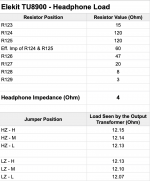 Screen Shot 2021-10-18 at 1.10.26 AM.png98.1 KB · Views: 267
Screen Shot 2021-10-18 at 1.10.26 AM.png98.1 KB · Views: 267 -
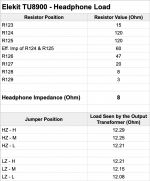 Screen Shot 2021-10-18 at 1.10.45 AM.png97.7 KB · Views: 273
Screen Shot 2021-10-18 at 1.10.45 AM.png97.7 KB · Views: 273 -
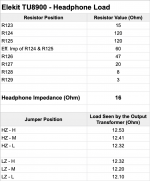 Screen Shot 2021-10-18 at 1.11.08 AM.png99 KB · Views: 258
Screen Shot 2021-10-18 at 1.11.08 AM.png99 KB · Views: 258 -
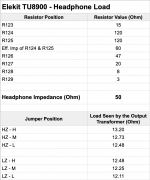 Screen Shot 2021-10-18 at 1.11.30 AM.png99.3 KB · Views: 248
Screen Shot 2021-10-18 at 1.11.30 AM.png99.3 KB · Views: 248 -
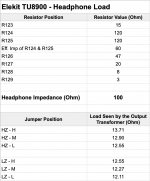 Screen Shot 2021-10-18 at 1.11.46 AM.png98.8 KB · Views: 82
Screen Shot 2021-10-18 at 1.11.46 AM.png98.8 KB · Views: 82 -
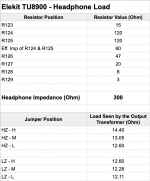 Screen Shot 2021-10-18 at 1.12.01 AM.png99.4 KB · Views: 120
Screen Shot 2021-10-18 at 1.12.01 AM.png99.4 KB · Views: 120 -
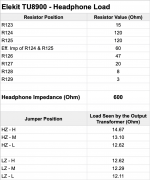 Screen Shot 2021-10-18 at 1.12.23 AM.png99.2 KB · Views: 98
Screen Shot 2021-10-18 at 1.12.23 AM.png99.2 KB · Views: 98
Last edited:
And here is how I am wiring the headphone board on mine. Literally skipping all the serial resistors (marked in red). For now I will be skipping the parallel resistors (marked in blue) too. But might put those in later to understand how those affect the sound. And where it is marked green, I have used a wire to jump, instead of the resistor.
The problem I foresee by skipping the resistor network are, i) the lack of headroom to finely adjust the volume and ii) noticeable hiss on headphones. I will definitely keep you posted on my findings.
Great detective work and plan EagleWings, I look forward to your results. I think your approach - and the potential shortcomings highlighted - are all spot on.
*
So to TLDR the last few pages, maybe I should just post a wishlist for my ideal Elekit, as a dedicated amp for normal headphones - that is, anything that is not the K1000, HE-6 or similar phones that would happily sit directly on the speaker taps.
- Appropriate gain for headphones; 3-5x voltage gain or +9-14dB (deafening with a 2VRMS source)
- Low noise far more important than maximum power, (1-2W is deafening for normal phones)
- As low Zout as possible, definitely aim for less than 5R, with no series resistor.
- Either a second higher Zout transformer tap, or a selector switch to add different series resistance for high Z phones.
- And hell, while I'm wish-listing, room to fit the big boy TKD 2CP2511 pot rather than just the 2CP601. Might as well go all in!
I'd be *really* surprised if there wasn't a market for a dedicated Elekit headphone system like this. Bottlehead does great business with dedicated headphone amp kits, and there is plenty of demand for Eddie Current and Donald North 2A3 and 300B headphone amps. And obviously a lot of interest in Elekit's super-professional-looking casing and PCB approach.
Last edited:
From what I have understood so far, a high impedance headphone should not harm the OPT or the amp in any manner. If I am not wrong, all the Eddie Current flagships (Studio, 445 and 2A3M4) use speaker OPTs and offer a headphone out without a resistor divider network. Problem arises when a low impedance load like a 4 Ohm IEM is connected. The resistor network on the 8900, acts as a fail-safe mechanism and makes sure that, regardless of the headphone being connected, the OPT will always see a load anywhere between 12-15 Ohm. See attached pics.
All the resistors that are part of the NFB network are on the speaker out board. None of the resistors on the headphone board contribute to the NFB network.
On the 8900, the output from the secondary winding of the OPT first comes to the 6.3mm headphone jack, and then goes to the speaker taps. The headphone jack on the 8900 has an inbuilt switch. When no headphone is connected, it outputs to the speaker taps. And when you connect a headphone, it breaks the connection to the speaker taps. As a result, the headphone out is the shorter path from the OPT on the 8900.
The problem I foresee by skipping the resistor network are, i) the lack of headroom to finely adjust the volume and ii) noticeable hiss on headphones. I will definitely keep you posted on my findings.
Why don’t you try connect directly from OTs ? R220 or R221 (120R) and R120/121 depend on which one you want to aim for. The Hi-Z is 8Ohm and Low-Z is 5 Ohm. That is if you want to use the NFB networks, and if you don’t, tap it right at CN202-102 terminal 3/4
Great detective work and plan EagleWings, I look forward to your results. I think your approach - and the potential shortcomings highlighted - are all spot on.
*
So to TLDR the last few pages, maybe I should just post a wishlist for my ideal Elekit, as a dedicated amp for normal headphones - that is, anything that is not the K1000, HE-6 or similar phones that would happily sit directly on the speaker taps.
- Appropriate gain for headphones; 3-5x voltage gain or +9-14dB (deafening with a 2VRMS source)
- Low noise far more important than maximum power, (1-2W is deafening for normal phones)
- As low Zout as possible, definitely aim for less than 5R, with no series resistor.
- Either a second higher Zout transformer tap, or a selector switch to add different series resistance for high Z phones.
- And hell, while I'm wish-listing, room to fit the big boy TKD 2CP2511 pot rather than just the 2CP601. Might as well go all in!
I'd be *really* surprised if there wasn't a market for a dedicated Elekit headphone system like this. Bottlehead does great business with dedicated headphone amp kits, and there is plenty of demand for Eddie Current and Donald North 2A3 and 300B headphone amps. And obviously a lot of interest in Elekit's super-professional-looking casing and PCB approach.
The low Z is already 5 ohms for standard, I don’t know about the Lundahl options
Attachments
Last edited:
AER BD3 118DB + TU-8900..... is a Prefect Combo
 https://flic.kr/p/2mBQpoz https://www.flickr.com/photos/64593884@N08/
https://flic.kr/p/2mBQpoz https://www.flickr.com/photos/64593884@N08/
 https://flic.kr/p/2mBQpoz https://www.flickr.com/photos/64593884@N08/
https://flic.kr/p/2mBQpoz https://www.flickr.com/photos/64593884@N08/